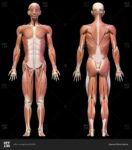Cardiac Cell Tissue Organ Representation
The heart, a critical organ that keeps blood moving throughout the body, is a muscular, four-chambered system that is responsible for pumping blood through the vascular network. The organ is located within the thoracic cavity in a region known as the mediastinum.
Cardiac Cells
Cardiac muscle cells, also known as cardiomyocytes, are elongated and somewhat tubular, like muscles themselves. The basic unit of a cardiomyocyte is the sarcomere, which consists mostly of contractile proteins and mitochondria. Mitochondria are tiny “power plants” that generate a fuel molecule called adenosine triphosphate (ATP) when oxygen is present. Cardiomyocytes have a single nucleus in the center of the cell, which helps to distinguish them from skeletal muscle cells that have multiple nuclei dispersed in the periphery of the cell.
Cardiac Tissue
Histologically, the heart is made of three layers of tissue: epicardium, myocardium, and endocardium.
1. Epicardium: The epicardium is the outermost layer of the heart. It is actually the visceral layer of the serous pericardium, which adheres to the myocardium of the heart. Histologically, it is made of mesothelial cells, the same as the parietal pericardium. Below the mesothelial cells is a layer of adipose and connective tissue that binds the epicardium to the myocardium and cushions the heart.
2. Myocardium: The myocardium is functionally the main constituent of the heart and the thickest layer of all three heart layers. It is a muscle layer that enables heart contractions. Histologically, the myocardium is comprised of cardiomyocytes.
3. Endocardium: The endocardium lines the inner surface of heart chambers and valves. It is comprised of a layer of endothelial cells, and a layer of subendocardial connective tissue.
Cardiac Organ
The heart is composed of left and right atria and ventricles. The atria are superior to (and less muscular than) the ventricles. The right and left atria are receptacles for blood coming from the body and lungs, respectively. On the other hand, the right and left ventricles eject blood from the heart to the lungs and body, respectively. As a result of this arrangement, the right side of the heart contains oxygen-poor blood, while the left side contains oxygen-rich blood.
In conclusion, the heart’s structure, from cells to tissues to the organ as a whole, is intricately designed to fulfill its vital role in the body. Each component, whether it’s the cardiomyocytes, the layers of tissue, or the organ itself, contributes to the heart’s primary function of pumping blood throughout the body..



